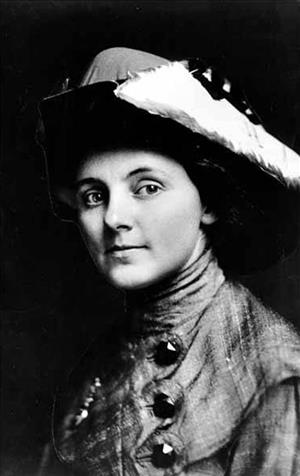Anna Louise Strong remains one of the notable radicals in the history of the United States. During her Seattle years (1910-1921), she won her election as the lone woman on the School Board, only to be recalled because of her overt sympathies with the Industrial Workers of the World (IWW or "Wobblies") and because of her pacifist stance during World War I. A journalist, she supported the working class in the Seattle General Strike (1919) and promoted the new Soviet government.
Gifted Child
Born in Friend, Nebraska, she was the daughter of middle-class liberals who were active in missionary work and the Congregational Church. An unusually gifted child, she raced through grammar and high school, then studied languages in Europe. She graduated from Bryn Mawr, did graduate work at Oberlin, and at age 23 earned her Ph.D. from the University of Chicago.
As an advocate for child welfare for the United States Education Office, she organized an exhibit and toured it extensively throughout the United States and abroad. When she brought it to Seattle in May 1914, it attracted more than 6,000 people per day, culminating with an audience of 40,000 on May 31.
Unable to find solutions for the needs of children and the working class, Strong concluded that capitalism was at fault and became an avowed socialist. She was 30 years old when she returned to Seattle to live with her father, the Reverend Sydney Strong, pastor of Queen Anne Congregational Church. She favored the political climate, which was pro-labor and progressive. She also enjoyed mountain climbing. She organized cooperative summer camps in the Cascades and led climbing parties up Mount Rainier.
Advocating for Schools and Labor
When Strong ran for the Seattle School Board in 1916, she won easily, thanks to support from women's groups and organized labor and thanks to her reputation as an expert on child welfare. She was the only female board member. She argued that the public schools should offer social service programs to ameliorate inequities for underprivileged children and that they should serve as community centers. But there was little she could do: Other members chose to devote meetings to practical matters like plumbing fixtures.
In the year of her election, 1916, the Everett Massacre occurred. Strong was hired as a stringer by the New York Evening Post to report on the bloody conflict between the IWW (or "Wobblies") and the army of armed guards hired by Everett mill owners to keep them out of town. At first an impartial observer, she soon became an impassioned and articulate spokesperson for workers' rights.
Strong's endorsement of controversial liberal causes set her apart from her colleagues on the school board. She opposed war as a pacifist, and when the United States entered World War I in 1917, she spoke out against the draft. On the one hand, the PTA and women's clubs joined her in opposing military training in the schools. On the other hand, the Seattle Minute Men, many of whom were veterans of the Spanish-American War, branded her as unpatriotic.
The pacifist stance of the Wobblies led to mass arrests at the Seattle office where Louise Olivereau, a typist, was mailing mimeographed circulars to draftees, urging them to consider becoming conscientious objectors. In 1918, Strong stood by Olivereau's side in the courtroom, as the typist-activist was tried for sedition, found guilty, and sent to prison.
Strong's fellow school board members were quick to launch a recall campaign against her. They won by a narrow margin. She appeared at their next meeting to argue that they appoint a woman as her successor. Her former colleagues acceded to her request, but they made it clear that they wanted a mainstream, patriotic representative, a mother with children in the schools. They replaced Anna Louise Strong with Evangeline C. Harper, a prominent club woman.
Strong became more openly associated with the liberal press, writing forceful pro-labor articles and promoting the new Soviet government. On February 6, 1919, two days before the beginning of the Seattle General Strike, she proclaimed in her famous editorial for the local Union Record: "We are undertaking the most tremendous move ever made by LABOR in this country, a move which will lead – NO ONE KNOWS WHERE!" The strike shut down the city for four days and then ended as it had begun – peacefully and with its goals still undefined.
Disillusioned with the erosion of the labor movement, Strong had nothing to keep her in Seattle. The next year when Lincoln Steffens lectured in Seattle about his trip to Russia, Strong accepted his advice and went to Moscow. For several years, she supported herself as a foreign correspondent for radical American newspapers. In 1958, at age 72, she moved to China, where she was one of few Westerners to gain the admiration of Mao Tse-tung. She remained there until her death in 1970.

